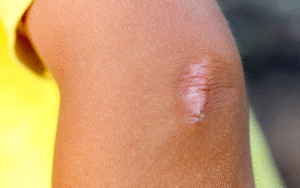Scars: A Journey Through Healing, Identity, and Transformation
Scars are more than just marks on the skin, they are stories etched into our bodies, reminders of resilience, and symbols of transformation. Here’s an expanded exploration of scars, delving deeper into their physical, emotional, and cultural dimensions.

1. The Anatomy of Scars: How They Form and Evolve
Scars are the body’s natural response to injury, but their formation is a complex process:
- Healing stages:
- Inflammation: The body sends white blood cells to clean the wound.
- Proliferation: Collagen fibers rebuild the tissue, often unevenly.
- Maturation: The scar remodels over months or years, becoming flatter and paler.
- Factors influencing scarring:
- Depth of injury: Deeper wounds lead to more pronounced scars.
- Genetics: Some people are prone to keloids or hypertrophic scars.
- Care during healing: Proper wound care reduces scarring risk.
2. Types of Scars: A Comprehensive Guide
Scars come in various forms, each with unique characteristics:
- Hypertrophic scars: Raised, red, and confined to the injury site.
- Keloids: Overgrown, extending beyond the wound, often itchy or painful.
- Atrophic scars: Sunken, caused by tissue loss (e.g., acne, chickenpox).
- Contracture scars: Tightened skin, often from burns, limiting mobility.
- Stretch marks: A type of scar caused by rapid skin stretching (e.g., pregnancy, growth spurts).
3. The Emotional Weight of Scars
Scars can carry emotional baggage or serve as symbols of strength:
- Psychological impact:
- Self-esteem: Visible scars may lead to insecurity or social anxiety.
- Trauma reminders: Scars can trigger memories of accidents, surgeries, or abuse.
- Positive perspectives:
- Resilience: Many view scars as proof of survival and strength.
- Identity: Scars can become part of one’s unique story.
4. Advanced Scar Treatments: Beyond the Basics
Modern medicine offers innovative ways to minimize scars:
- Laser therapy: Reduces redness and improves texture.
- Microneedling: Stimulates collagen production for smoother skin.
- Steroid injections: Flattens raised scars like keloids.
- Surgical revision: Excises and re-closes scars for a cleaner appearance.
- Natural remedies: Aloe vera, honey, and coconut oil can aid healing (though results vary).
5. Scars in Culture and Art: A Universal Symbol
Scars have fascinated humanity for centuries, appearing in art, literature, and rituals:
- Cultural significance:
- Tribal markings: Scars as symbols of identity, status, or rites of passage.
- Religious symbolism: Some cultures view scars as divine signs or sacrifices.
- Artistic representations:
- Literature: Scars often symbolize transformation (e.g., Frankenstein’s monster).
- Film and TV: Characters with scars are portrayed as complex—heroes, villains, or survivors.
- Body positivity: Movements like #ScarredNotScared encourage embracing scars as part of one’s beauty.
6. Embracing Scars: A Path to Self-Acceptance
Learning to live with scars is a journey of self-love and empowerment:
- Reframing the narrative: Instead of hiding scars, celebrate them as part of your story.
- Creative expression: Tattoos, makeup, or photography can transform scars into art.
- Community support: Sharing stories with others fosters connection and healing.
7. Scars and the Future: Innovations in Healing
The future of scar treatment is promising, with advancements like:
- Regenerative medicine: Stem cell therapy to regenerate healthy skin.
- Smart dressings: Wound coverings that release healing agents.
- Gene editing: Potential to reduce scar formation at the genetic level.
Final Reflection
Scars are a testament to the body’s incredible ability to heal and the human spirit’s capacity to endure. They remind us that life’s challenges leave their mark, but they also shape who we are. Whether you see them as flaws, badges of honor, or works of art, scars are an integral part of the human experience.
